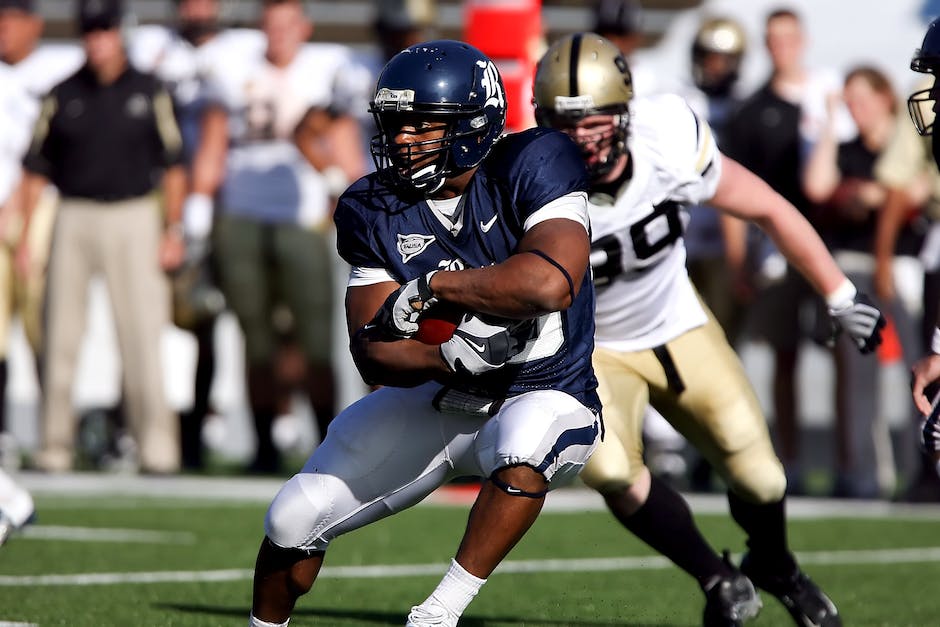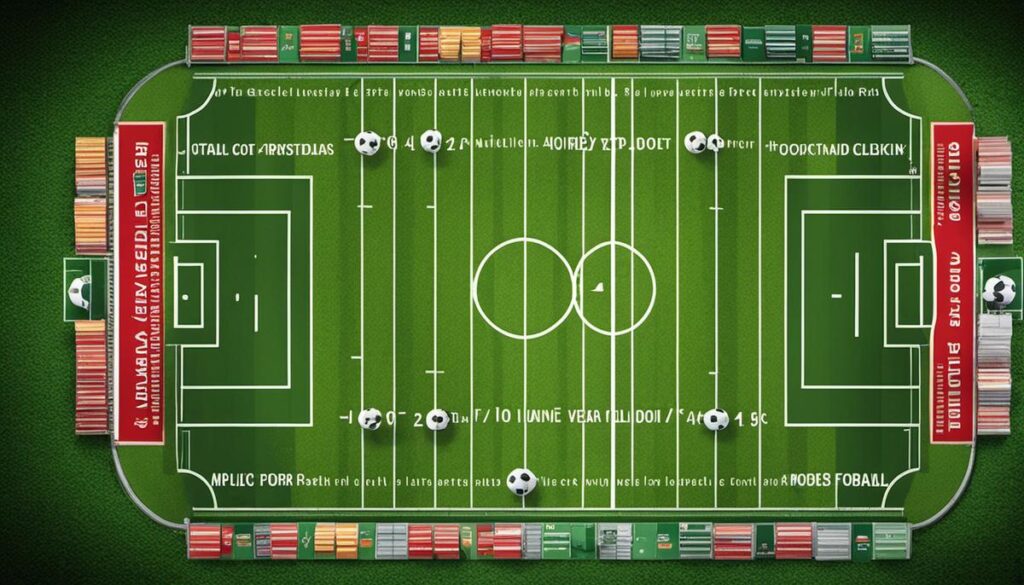Football, a game of strategy and skill, and the most popular sport in the United States, is a complex interplay between numerous positions, each with its own significant responsibility. This intricate game relies heavily on the understanding of these football positions and how they coordinate together as a team. A thorough knowledge of each role, be it offense, defense or special teams, can greatly enhance the overall grasp and appreciation of the sport. In the following sections, we are going to expand on the basic football positions, delve deeply into each offensive and defensive role, and explore what makes each player essential in the grand orchestration of the game
Overview of Football Positions
Offensive Positions
American Football games consist of two main types of squad: the offensive team and the defensive team. The offensive team possesses the ball and aims to score points by advancing the ball down the field into the opponent’s end zone.
The quarterback (QB) operates as the team’s play-caller and leader on the field. The QB throws passes, hands off the ball to a running back, or runs with it themselves.
The running backs (RB) are usually behind or beside the quarterback and are handed the ball to run with it. The fullback (FB) is a specific type of running back known for their blocking capabilities.
The offensive line (OL) is tasked with protecting the quarterback and creating space for the running backs. The offensive line consists of two tackles (T), two guards (G), and a center (C) who snaps the ball to the QB.
Wide receivers (WR) and tight ends (TE) are the primary targets for the quarterback’s passes. WRs tend to operate on the edges of the field, with speed being a key attribute, while TEs usually line up alongside the offensive line and balance their responsibilities between blocking and catching passes.
Defensive Positions
On the defensive side, players aim to prevent the opposing offense from scoring by intercepting passes, blocking kicks, or forcing fumbles. The defensive team organizes itself into three main groups: the defensive line, the linebackers, and the defensive backs.
The defensive line (DL) is generally made up of two tackles (DT) and two ends (DE), although the exact arrangement may change based on the team’s defensive scheme. Their job is to disrupt the offensive line and stop running plays.
The linebackers (LB) sit behind the defensive line and are arguably the most versatile players on the field, needing to be strong enough to collide with offensive players but agile enough to cope with pass coverage. They can be broken into middle linebackers (MLB) and outside linebackers (OLB) depending on their placement.
The defensive backs are divided into cornerbacks (CB) and safeties (S). Cornerbacks aim to prevent wide receivers from catching passes, while the safeties provide long pass coverage and are often the last line of defense.
Special Teams Positions
Lasty, the special teams come on for kicking situations. This includes a kicker (K) for kickoffs and field goals, a punter (P) for punting, a long snapper (LS) who snaps the ball in kicking situations, and return specialists (RS) who return kicks and punts.
Comprehending the roles and responsibilities of each position provides a richer understanding of the sport of football. The essence of the game lies in teamwork and coordination, as is the case with any sport. The most accomplished teams achieve success through flawless synchronization, where each member comprehends and delivers their role to the best of their abilities.

Deep Dive into Offensive Positions
Quarterback
One of the most pivotal offensive roles in football is that of the quarterback, frequently viewed as the team’s leader. Their duties range from calling plays and passing the ball, to sometimes running with it. Key skills for this position are exceptional vision, accurate throwing, and the ability to make split-second decisions under high-pressure situations. Tom Brady, an iconic figure in the NFL, exemplifies these qualities with his precision passing and formidable strategic thinking.
Running Back
The running back’s primary role is to run the ball downfield, advancing the ball as far as they can while evading the opposing team’s defenses. However, a running back may also serve as a receiver and block for the quarterback. Key skills include speed, agility, strength, and the ability to spot and exploit space on the field. A notable example of a running back is Emmitt Smith, known for his power running and ability to make explosive plays.
Wide Receiver
Wide receivers are key to a football team’s passing offense. They’re responsible for running routes downfield and catching passes thrown by the quarterback. Speed, agility, and excellent hand-eye coordination are pivotal for this position. Beyond that, having a strong understanding of plays and the ability to read the defense is crucial. Jerry Rice, considered one of the greatest wide receivers in NFL history, is known for his precise route running and unmatched catching ability.
Tight End
The tight end is a hybrid position that combines the roles of an offensive lineman and a wide receiver. They’re expected to block for running backs and quarterbacks, but they also go out for passes. This position requires size and strength for blocking, but also speed and agility to run routes and catch passes. A famous example is Rob Gronkowski, known for both his blocking ability and as a formidable receiving target.
Offensive Lineman
When it comes to football positions, let’s start at the heart of the offensive lineup with the offensive lineman. This contingent consists of five essential players that make up the offensive line: they are the center, two guards, and the two tackles. These big guys have a crucial task on their hands – to provide solid defensive blockade for the quarterback and the running backs. This shields them from the relentless pursuit of the defensive players. Of course, to perform in this role, substantial size, formidable strength, and also a thorough understanding of complex blocking schemes are required. The respect and admiration accorded to standouts in this position is quite extraordinary, with Anthony Munoz being frequently touted as one of the greatest offensive lineman in the history of the NFL.

Deep Dive into Defensive Positions
Linebackers
Moving on to the defensive side of the game, the linebackers can aptly be described as the “frontline warriors” of a football team. These players offer a dynamic impact, often proving to be the most integral part of the defense. Their roles are fluid, frequently interchanging based on the gameplay and situation at hand. You can differentiate between three types of linebackers: the middle linebacker (MLB), weakside linebacker (WLB), and the strongside linebacker (SLB). The MLB is functionally similar to the quarterback but on defense. This player needs durability and grit. Conversely, the WLB has speed on their side, often deployed to cover the field’s weak side. Lastly, the SLB’s role entails providing coverage to the strong side – a task requiring an optimal blend of both speed and power. Throughout the history of the sport, players like Ray Lewis and Dick Butkus have greatly personified the linebacker position, known for both their incredible athleticism and indomitable leadership on the field.
Defensive Backs
Defensive backs are the final line of defense and often the last chance to stop an opponent from making a big play. Grouped into two categories; Cornerbacks (CB) and Safeties (S). The CB’s primary responsibility is to cover wide receivers, limiting their ability to catch passes. They require speed, agility, and the ability to react quickly to movements. Safeties, divided into Free Safety (FS) and Strong Safety (SS), operate further downfield. While the FS generally plays a more reactive, cover-based role, the SS is more aggressive, often brought closer to the line of scrimmage to counter running plays or short passes. Famous figures in these roles include Deion Sanders and Ronnie Lott, who were known to break up potential big plays by the opposing team.
Defensive Linemen
Defensive linemen are typically the biggest, strongest players on the field. This grouping consists of defensive tackles (DT) and defensive ends (DE). The DTs are centrally positioned and are the first line of defense against the running attack. They also aim to pressure the quarterback on passing plays. DEs are on the outside, and while also play a significant part against runs, they also apply pressure from the edge to the quarterback. When successful, this often results in a sack. Together, these positions form the defensive line, aiming to control the line of scrimmage, dictate play, and disrupt the offense’s rhythm. Iconic defensive linemen include Reggie White and Joe Greene, commended for their ability to dominate opponents and dictate play.
To grasp the essence of football, it’s important to understand that each defensive position contributes uniquely to a collective strategy. Their primary aim is to halt the opposing team’s progress and to regain possession of the ball. Each player’s diverse skills and physical attributes become apparent across the field – from brute strength on the line to swift agility in the secondary. Functioning as a unit, these players create an impenetrable barricade that forms an effective defensive wall.

Understanding Special Teams Positions
Kickers
The kicker’s role in a football game often tends to be marginalized despite its significant impact on the game results. These placekickers carry out pivotal tasks such as initiating the game from their team’s 35-yard line (or 30-yard line in college football) in each half, and after every score. They execute the extra point following a touchdown and can use their precise kicking skills to score a field goal from anywhere on the field. One of their notable tasks is the onside kicks, a daring attempt to recapture possession after a score. Possessing attributes like precision and power is crucial to excel as a standout kicker.
Punters
If kickers are the snipers of football, then punters are the artillery. Typically called upon on fourth-down situations to kick the ball as far as possible from their end zone, the aim is to get the opposition as close to their end zone and as far from scoring as possible. It’s not just about kicking it far though, punters need to have excellent control to pin the opposition team back as close to their own goal line as possible. Effective punters can put teams in difficult starting positions, effectively swaying the momentum of the game.
Long Snapper
A long snapper doesn’t get many headlines, but they’re an integral part of special teams. The long snapper is the player who snaps the ball to the punter or the holder during field goal or extra point attempts. Their performance can determine the success of the play, and a perfect snap is often taken for granted. An errant snap, however, could prove deadly to a team’s scoring chances.
Return Specialists
The kick returner and punt returner, known collectively as return specialists, have the responsibility of catching the opposition’s kickoffs and punts, then running the ball back as far as possible. They’re usually the fastest players on the teams, equipped with the agility to dodge oncoming tacklers and find the tiniest of gaps in the defense. They can change the momentum of a game with a long return, or even a touchdown.
Gunners
Gunners are basically the first line of defense on punt plays. They’re usually among the fastest players on a team and their role is to race down the field and tackle the punt returner or force a fumble. They are often double-teamed by the receiving team, making the role not just one of speed, but also of strength and agility.
Jammer
The jammer is a key role on punt return units. Their job is to stop the gunners from reaching the punt returner. Skillful jammers can create enough space and time for a returner to make a big game-changing return. They need to have strength to block, speed to keep up with the gunner, and enough football acumen to avoid committing a penalty.
Each of these overlooked roles plays a very significant part in a football game. Without them, the outcomes of the games could be drastically different, which shows they’re every bit as important as more recognized positions like quarterback or receiver.

Football is a captivating sport that requires an in-depth understanding of the various positions and their respective responsibilities to fully appreciate it. From the maneuverability of quarterbacks, the endurance of running backs, to the strategic responsibilities of linebackers and the precision of kickers, each role is interwoven into the fabric of the game. Every position, whether offensive, defensive or special teams, contributes considerably to the ultimate success of the team. Recognizing these positions and the impact each one has on the outcome of the game helps us appreciate football for the complex and intense sport that it truly is.




